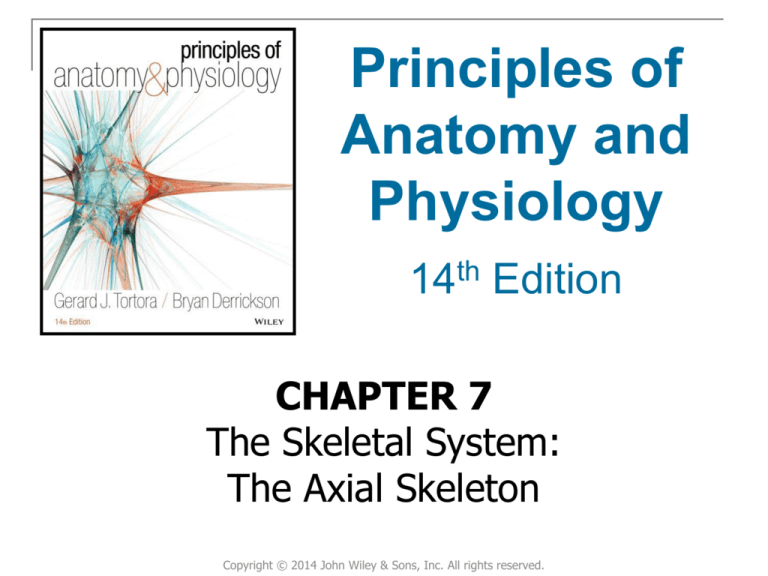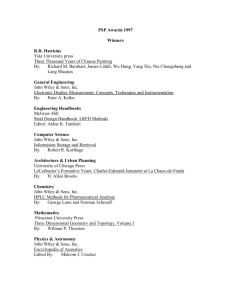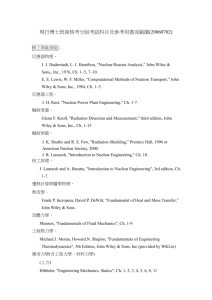
Principles of
Anatomy and
Physiology
14th Edition
CHAPTER 7
The Skeletal System:
The Axial Skeleton
Copyright © 2014 John Wiley & Sons, Inc. All rights reserved.
Divisions of the Skeletal System
The human skeleton consists of 206 named
bones grouped into two principal divisions:
Axial skeleton (80 bones)
Appendicular skeleton (126 bones)
Copyright © 2014 John Wiley & Sons, Inc. All rights reserved.
Divisions of the Skeletal System
The axial skeleton:
Skull bones, auditory ossicles (ear bones), hyoid
bone, ribs, sternum (breastbone), and bones of
the vertebral column.
The appendicular skeleton:
Bones of the upper and lower limbs (extremities)
and the bones forming the girdles that connect the
limbs to the axial skeleton.
Copyright © 2014 John Wiley & Sons, Inc. All rights reserved.
Divisions of the Skeletal System
Anatomy Overview:
The Skeletal System
You must be connected to the Internet and in Slideshow Mode
to run this animation.
Copyright © 2014 John Wiley & Sons, Inc. All rights reserved.
Types of Bones
Almost all bones are
classified into 5 main
types based on shape:
Long (greater seed length
than width
Short (cube shaped)
Flat (thin layers of parallel
plates)
Irregular (complex
shapes)
Sesamoid (shaped like a
sesame seed )
Copyright © 2014 John Wiley & Sons, Inc. All rights reserved.
Types of Bones
Sutural bones are small, extra bone plates
located within the sutures of cranial bones.
Sutures are the jointed areas where flat
bones come together.
Copyright © 2014 John Wiley & Sons, Inc. All rights reserved.
Bone Surface Markings
Bones have characteristic surface markings
– structural features adapted for specific
functions.
There are two major types of surface
markings:
Depressions and openings
Allow the passage of soft tissues
Form joints
Processes
Projections or outgrowths that form joints
Serve as attachment points for ligaments and tendons
Copyright © 2014 John Wiley & Sons, Inc. All rights reserved.
Bone Surface Markings
Fissure: Narrow
slit between bones
for passage of
blood vessels or
nerves.
Copyright © 2014 John Wiley & Sons, Inc. All rights reserved.
Bone Surface Markings
Foramen: Hole for
passage of blood
vessels, nerves or
ligaments.
Copyright © 2014 John Wiley & Sons, Inc. All rights reserved.
Bone Surface Markings
Fossa: Shallow
depression.
Copyright © 2014 John Wiley & Sons, Inc. All rights reserved.
Bone Surface Markings
Sulcus: Furrow on a bone for passage of
blood vessel, nerve or tendon.
Meatus: Tubelike opening
Copyright © 2014 John Wiley & Sons, Inc. All rights reserved.
Bone Surface Markings
Condyle: Rounded projection with a smooth
articular surface.
Copyright © 2014 John Wiley & Sons, Inc. All rights reserved.
Bone Surface Markings
Facet: Smooth, flat, slightly concave
articular surface.
Copyright © 2014 John Wiley & Sons, Inc. All rights reserved.
Bone Surface Markings
Head: Usually rounded articular process
supported on a neck.
Copyright © 2014 John Wiley & Sons, Inc. All rights reserved.
Bone Surface Markings
Crest:
Prominent ridge
or elongated
process.
Copyright © 2014 John Wiley & Sons, Inc. All rights reserved.
Bone Surface Markings
Epicondyle:
Usually roughened
projection on a
condyle.
Line: Long, narrow
ridge or border (less
prominent than a
crest
Copyright © 2014 John Wiley & Sons, Inc. All rights reserved.
Bone Surface Markings
Spinous process: Sharp, slender
projection.
Copyright © 2014 John Wiley & Sons, Inc. All rights reserved.
Bone Surface Markings
Trochanter: Very
large projection
found ONLY on the
femur.
Tubercle: Variably
sized rounded
projection.
Copyright © 2014 John Wiley & Sons, Inc. All rights reserved.
Bone Surface Markings
Tuberosity: Variably sized projection with
rough, bumpy surface.
Copyright © 2014 John Wiley & Sons, Inc. All rights reserved.
Skull
The skull contains 22 bones, not including
the 3 middle ear bones in both ears.
Associated with these bones are a number
of processes, ridges, lines, depressions and
foramen.
Copyright © 2014 John Wiley & Sons, Inc. All rights reserved.
Skull
Copyright © 2014 John Wiley & Sons, Inc. All rights reserved.
Skull
Copyright © 2014 John Wiley & Sons, Inc. All rights reserved.
Skull
Copyright © 2014 John Wiley & Sons, Inc. All rights reserved.
Skull
Copyright © 2014 John Wiley & Sons, Inc. All rights reserved.
Skull
Copyright © 2014 John Wiley & Sons, Inc. All rights reserved.
Skull
Copyright © 2014 John Wiley & Sons, Inc. All rights reserved.
The Mandible
The mandible (lower jawbone) is the largest
and strongest facial bone. Other than the
middle ear bones (auditory ossicles) it is the
only moveable skull bone.
Copyright © 2014 John Wiley & Sons, Inc. All rights reserved.
The Paranasal Sinuses
The paranasal sinuses are mucous
membrane-lined cavities in the frontal,
maxillary, sphenoid and ethmoid bones.
They are used as resonating (echo)
chambers to enhance the voice as well as
structures that increase the surface area
of the nasal mucosa and help to moisten
it as well.
Copyright © 2014 John Wiley & Sons, Inc. All rights reserved.
The Paranasal Sinuses
Copyright © 2014 John Wiley & Sons, Inc. All rights reserved.
Fontanels
Fontanels are mesenchyme-filled spaces
between cranial bones present at birth. They
close up beginning at 6 months of age
through 2 years (depending on the fontanel).
Copyright © 2014 John Wiley & Sons, Inc. All rights reserved.
Hyoid Bone
The hyoid
bone supports
the tongue by
attaching to
muscles. It is
situated at the
top of the
larynx.
Copyright © 2014 John Wiley & Sons, Inc. All rights reserved.
The Vertebral Column
The vertebral column is also
known as the spinal column,
backbone and spine. It is
made up of 26 vertebrae
divided into 5 regions. The
lower regions, the sacrum
(made up of 5 fused
vertebrae) and the coccyx
(made up of 4 fused
vertebrae) are not individual
bones as are the other 24
vertebrae. The column
protects the spinal cord.
Copyright © 2014 John Wiley & Sons, Inc. All rights reserved.
The Vertebral Column
Intervertebral discs separate the vertebrae
from one another. They are located between
the bodies of the vertebrae from the second
cervical to the sacrum. Each disc has an
outer ring of fibrocartilage (annulus fibrosus)
which surrounds soft, pulpy nucleus
(nucleus pulposus). The top and bottom of
each disc has a layer of hyaline cartilage.
They are used to absorb shock and create
spaces between vertebrae.
Copyright © 2014 John Wiley & Sons, Inc. All rights reserved.
The Vertebral Column
Copyright © 2014 John Wiley & Sons, Inc. All rights reserved.
The Vertebral Column
A typical vertebra is composed of several
parts. Vertebrae from each region, in
addition to containing common structures,
have unique structures that help to identify
which type they are. In addition, the first 2
cervical vertebrae are different from the
others in shape and function.
Copyright © 2014 John Wiley & Sons, Inc. All rights reserved.
The Vertebral Column
Copyright © 2014 John Wiley & Sons, Inc. All rights reserved.
The Vertebral Column
The thoracic vertebrae support the ribs and
have special structures for rib head and
tubercle attachment.
Copyright © 2014 John Wiley & Sons, Inc. All rights reserved.
The Vertebral Column
Copyright © 2014 John Wiley & Sons, Inc. All rights reserved.
The Vertebral Column
The lumbar vertebrae are the largest and
strongest in the vertebral column. They
support the body’s weight. There are no
special structures that are specifically
associated with these vertebrae.
Copyright © 2014 John Wiley & Sons, Inc. All rights reserved.
The Vertebral Column
The triangular-shaped sacrum is composed
of 5 vertebrae that begin to fuse together
between 16 and 18 years of age. The
process ends at around 30 years of age. It
is part of the pelvic girdle.
The coccyx is also triangular in shape and
is composed of 4 vertebrae that fuse
together between 20 and 30 years of age.
Copyright © 2014 John Wiley & Sons, Inc. All rights reserved.
The Vertebral Column
Copyright © 2014 John Wiley & Sons, Inc. All rights reserved.
Thoracic Bones
The sternum, or breastbone, is flat and is
located in the center of the anterior thoracic
wall. It is divided into three segments: The
upper manubrium, the middle body and the
lower xiphoid process. The three bones
usually fuse by 25 years of age. The
sternum articulates with the clavicles and
the costal cartilages from the ribs.
Copyright © 2014 John Wiley & Sons, Inc. All rights reserved.
Thoracic Bones
Copyright © 2014 John Wiley & Sons, Inc. All rights reserved.
Thoracic Bones
The ribs provide support to the thoracic cavity.
There are twelve pairs that extend from the
thoracic vertebrae to the sternum. The bony
portion ends a few inches from the sternum and
is connected to costal (hyaline) cartilage which
attaches to the sternum. The first 7 pairs are
called the true ribs because their cartilage is
directly connected to the sternum. The next 5
pairs are called false ribs because their cartilage
is indirectly connected to the sternum (pairs 8–
10) or not connected at all (pairs 11 and 12)
Copyright © 2014 John Wiley & Sons, Inc. All rights reserved.
Thoracic Bones
Copyright © 2014 John Wiley & Sons, Inc. All rights reserved.
Disorders
Many disorders may occur that affect the skeleton
in one form or another. In the vertebral column, a
herniated disc may occur due to trauma or,
sometimes, simply associated with aging. In these
cases, the nucleus pulposus is able to leak out due
to a tear in the annulus fibrosus.
Copyright © 2014 John Wiley & Sons, Inc. All rights reserved.
Disorders
At times, the normal curves of the spinal
column may become exaggerated. There
are many causes for these changes. These
curve-related pathologies include:
Scoliosis (increased lateral curvature)
Kyphosis (increased thoracic curve-bent forward)
Lordosis (increased lumbar curve-bent
backwards)
Copyright © 2014 John Wiley & Sons, Inc. All rights reserved.
Disorders
Copyright © 2014 John Wiley & Sons, Inc. All rights reserved.
Disorders
Spina bifida is a congenital defect of the
vertebral column where the laminae do not
develop normally. The degrees of this
deformity vary from minor (spina bifida
occulta) to severe (spina bifida with
meningomyelocele). In the latter case, a
cystlike sac containing the meninges,
cerebrospinal fluid and the spinal cord
and/or its nerve roots protrudes from the
spinal column.
Copyright © 2014 John Wiley & Sons, Inc. All rights reserved.
Disorders
Spina bifida with meningomyelocele
Copyright © 2014 John Wiley & Sons, Inc. All rights reserved.
End of Chapter 7
Copyright 2014 John Wiley & Sons, Inc.
All rights reserved. Reproduction or translation of this
work beyond that permitted in section 117 of the 1976
United States Copyright Act without express
permission of the copyright owner is unlawful. Request
for further information should be addressed to the
Permission Department, John Wiley & Sons, Inc. The
purchaser may make back-up copies for his/her own
use only and not for distribution or resale. The
Publisher assumes no responsibility for errors,
omissions, or damages caused by the use of these
programs or from the use of the information herein.
Copyright © 2014 John Wiley & Sons, Inc. All rights reserved.








